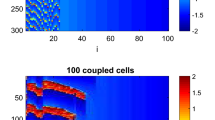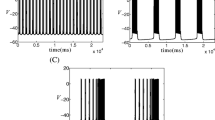Abstract
In bursting excitable cells such as pancreaticβ-cells and molluscanAplysia neuron cells, intracellular Ca2+ ion plays a central role in various cellular functions. To understand the role of [Ca2+] i (the intracellular Ca2+ concentration) in electrical bursting, we formulate a mathematical model which contains a few functionally important ionic currents in the excitable cells. In this model, inactivation of Ca2+ current takes place by a mixture of voltage and intracellular Ca2+ ions. The model predicts that, although the electrical bursting patterns look the same, the shapes of [Ca2+] i oscillations could be very different depending on how fast [Ca2+] i changes in the cytosolic free space (i.e., how strong the cellular Ca2+ buffering capacity is). If [Ca2+] i changes fast, [Ca2+] i oscillates in bursts in parallel to electrical bursting such that it reaches a maximum at the onset of bursting and a minimum just after the termination of the plateau phase. If the change is slow, then [Ca2+] i oscillates out-of-phase with electrical bursting such that it peaks at a maximum near the termination of the plateau and a minimum just before the onset of the active phase. During the active phase [Ca2+] i gradually increases without spikes. In the intermediate ranges, [Ca2+] i oscillates in such a manner that the peak of [Ca2+] i oscillation lags behind the electrical activity. The model also predicts the existence of multi-peaked oscillations and chaos in certain ranges of the gating variables and the intracellular Ca2+ buffer concentration.
Similar content being viewed by others
References
Chay TR (1988) Mathematical modeling for the bursting mechanism of insulin secretingβ-cell. Comm Mol Cell Biophys 4:349–368
Cook DL, Ikeuchi M, Fujimoto WY (1984) Lowering of pH inhibits calcium-activated potassium channels in isolated rat pancreatic islet cells. Nature 311:269–271
Dean PM, Mathews EK (1970) Glucose-induced electrical activity in pancreatic islet cells. J Physiol 210:255–264
Findlay IM, Dunne J, Petersen OH (1985) High-conductance K+ channel in pancreatic islet cells can be activated and inactivated by internal calcium. J Mem Biol 83:169–175
Gleick J (1987) Chaos: making a new science. Viking Press, New York
Gorman ALF, Hermann A, Thomas MV (1982) Ionic requirements for membrane oscillations and their dependent on the calcium concentration in a molluscan pace-maker neurone. J Physiol 327:185–217
Henquin JC, Schmeer W, Nenquin M, Meissner HP (1985) Effects of a calcium channel agonist on the electrical, ionic and secretory events in mouse pancreaticB-cells. Biochem Biophys Res Commun 131:980–986
Hodgkin A, Huxley AF (1952) A quantitative description of membrane current and its application to conduction and excitation in nerve. J Physiol (London) 117:500
Jones SW, Adams PR (1987) TheM-current and other potassium currents of vertebrate neurons. In: Kaczmarek LK, Levitan IB (eds) Neuronmodulation, the biochemical control of neuronal excitability. Oxford University Press, New York
Junge D, Stephens CL (1973) Cyclic variation of potassium conductance in a burst-generating neurone in Aplysia. J Physiol 235:155–181
Kramer RH, Zucker RS (1985) Calcium-induced inactivation of calcium current causes the inter-burst hyperpolarization ofAplysia bursting pace-maker neurons. J Physiol 363:131–160
May RM (1976) Simple mathematical models with very complicated dynamics. Nature 261:459–467
Meissner HP, Schmelz H (1974) Membrane potential of beta-cells in pancreatic islets. Pflugers Arch 351:195–206
Nowycky MC, Fox AP, Tsien RW (1985) Three types of neuronal calcium channel with different calcium agonist sensitivity. Nature 316:440–443
Plant TD (1988) Calcium current inactivation in cultured mouse pancreatic islet cells is calcium-dependent. J Physiol 404:731–747
Rorsman P, Trube G (1986) Calcium and delayed potassium currents in mouse pancreaticβ-cells under voltage-clamp conditions. J Physiol 374:531–550
Satin LS, Cook DL (1989) Calcium current inactivation in an insulin-secreting clonal cell line is mediated by both calcium influx and membrane depolarization. Pflugers Arch 414:1–10
Satin LS, Hopkins WF, Fatherazi S, Cook DL (1989) Expression of a rapid, low-voltage threshold K current in insulin-secreting cells is dependent on intracellular calcium buffering. J Mem Biol 112:213–222
Soria B, Ferrer R (1986) Graded spike electrogenesis in mouse pancreaticβ-cells. Adv Exp Med Biol 211:235–246
Strumwasser F (1968) Membrane and intracellular mechanism governing endogenous activity in neurons. In: Carlson FD (eds) Physiological and biochemical aspects of nervous integration. Prentice-Hall, Englewood Cliffs, NJ, pp 329–341
Wong BS, Lecar H, Adler M (1982) Single calcium-dependent potassium channels in clonal anterior pituitary cells. Biophys J 39:313–317
Author information
Authors and Affiliations
Additional information
This work was supported by NSF DCB-8819245 and NIH R01 HL 33905
Rights and permissions
About this article
Cite this article
Chay, T.R. Electrical bursting and intracellular Ca2+ oscillations in excitable cell models. Biol. Cybern. 63, 15–23 (1990). https://doi.org/10.1007/BF00202449
Received:
Accepted:
Issue Date:
DOI: https://doi.org/10.1007/BF00202449




